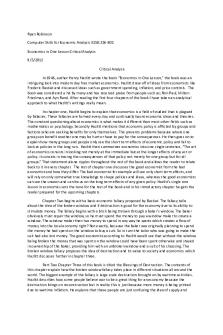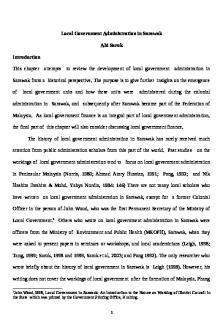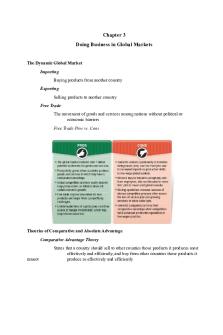Economics Summaries: Government Actions in Markets PDF

| Title | Economics Summaries: Government Actions in Markets |
|---|---|
| Author | Sarah Irons |
| Course | Intro to Microeconomics |
| Institution | University of Waterloo |
| Pages | 5 |
| File Size | 107 KB |
| File Type | |
| Total Downloads | 31 |
| Total Views | 121 |
Summary
Download Economics Summaries: Government Actions in Markets PDF
Description
Government Actions in Markets. A housing market with a rent ceiling
Price ceiling/ cap: a government regulation that makes it illegal to charge a price higher than a specified level. A price ceiling set above the equilibrium price has no effect because it does not constrain the market forces. A price ceiling below the equilibrium price has powerful effects on a market because it attempts to prevent the price from regulating the quantities demanded and supplied. Rent ceiling: when a price ceiling is applied to a housing market. A rent ceiling set below the equilibrium rent creates
A housing shortage In a housing market, when the rent is at the equilibrium level, the quantity of housing supplied equals the quantity of housing demanded and there is neither a shortage nor a surplus of housing. Rent set below the equilibrium rate: housing shortage. When there is a shortage, the quantity available is the quantity supplied, and somehow, this quantity must be allocated among the demanders. Increased search activity Search activity: the time spent looking for someone with whom to do business with. When the price is regulated and there is a shortage, search activity increases. A black market Black market: an illegal market in which the equilibrium price exceeds the price ceiling. With loose enforcing the black market rent is close to the unregulated rent. With strict enforcement, it is equal to the maximum price that a renter is willing to pay. Inefficiency of a rent ceiling A rent ceiling set below the equilibrium rent results in an inefficient underproduction of housing services. The marginal social benefit from housing exceeds its marginal social cost and a deadweight loss shrinks the producer surplus. A labor market with a minimum wage Price floor: a government imposed regulation that makes it illegal to charge a price lower than a specified level. A price floor set below the equilibrium price has no effect on a market
A price floor set above the equilibrium price has powerful effects on the market.
Minimum wage: when a price floor is applied to a labor market. When a minimum wage is set above the equilibrium wage, the quantity of labor supplied exceeds the quantity of labor demanded. (Surplus of labor) An unregulated labor market allocates the economy’s scarce labor resources to do the jobs in which they are valued most highly. The market is inefficient. Taxes Tax incidence: the division of the burden of a tax between buyers and sellers. When the government imposes a tax on the sale of a good, the price paid by buyers rises by the full amount of the tax , by a lesser amount, or not at all. The employment insurance tax: an example of a tax that the federal government imposes on both buyers of labor (employers) and sellers of labor (employees) Tax incidence and elasticity of demand Perfectly inelastic demand – Buyers pay. Perfectly elastic demand – Sellers pay Tax incidence and elasticity of supply Perfectly inelastic supply – sellers pay Perfectly elastic supply – buyers pay Taxes and fairness The benefits principle The proposition that people should pay taxes equal to the benefits they receive from the services provided by the government. The ability to pay principle The proposition that people should pay taxes according to how easily they can bear the burden of the tax. Production quotas
An upper limit to the quantity of a good that may be produced in a specific period. (Ex. milk, eggs, poultry) A production quota set below the equilibrium quantity has big effects: o A decrease in supply o A rise in price o A decrease in marginal cost o Inefficient underproduction
o An incentive to cheat and overproduce Decrease in supply Ex. a production quota on milk decreases the supply of milk. Each farmer is assigned a production limit that is less than the amount that would be produced and supplied without the quota. The total of the farmers’ limits equals the quota and any production of excess of the quota is illegal. The quantity supplied becomes the amount permitted by the production quota and this quantity is fixed. The supply of milk becomes perfectly inelastic at the quantity permitted under the quota. Rise in price Ex. the production quota raises the price of milk. When the government sets a production quota, it leaves market forces free to determine the price. Because the quota decreases the supply of milk, it raises the price. A decrease in marginal cost Marginal cost decreases because farmers produce less and stop using the resources with the highest marginal cost. Inefficiency Marginal social benefit at the quantity produced is equal to the market price, which has increased. Marginal social cost at the quantity produced has decreased and is less than the market price. So marginal social benefit exceeds marginal social cost and a deadweight loss arises An incentive to cheat and overproduce With the quota, the price exceeds marginal cost, so the farmer can get a larger profit by producing one more unit. To make production effective, farmers must set up a monitoring system to ensure that no one cheats and overproduces. Subsidies Subsidy: a payment made by the government to a producer. Effects of a subsidy: An increase in supply A fall in price and increase in quantity produced An increase in marginal cost Payments by government to farmers
Inefficient overproduction. Markets for illegal goods
A free market for a drug Demand curve: other things remaining the same, the lower the price of the drug, the larger is the quantity of the drug demanded. Supply curve: other things remaining the same, the lower the price of the drug, the smaller is the quantity supplied A market for an illegal drug When a good is illegal, the cost of trading in the good increases. By how much the cost increases and who bears the cost depend on the penalties for violating the law and the degree to which the law is enforced. Penalties on sellers Drug dealers could serve jail time. To determine the new supply curve, add the cost of breaking the law to the minimum price that drug dealers are willing to accept. Penalties on buyers Possession of illegal drugs can result in prison terms and fines. The cost of breaking the law must be subtracted from the value of the good to determine the maximum price buyers are willing to pay for drugs. Demand decreases and the demand curve shifts to the left. Penalties on both buyers and sellers Both supply and demand decrease and both the supply curve and the demand curve shift The larger the penalties and the greater the degree of law enforcement, the larger is the decrease in demand and/or supply. Legalizing and taxing drugs Imposing a significantly high tax could decrease the supply, raise the price and achieve the same decrease in the quantity bought as does a prohibition on drugs. Illegal trading to evade the tax If the penalty for tax law violation is as severe and as effectively policed as drug-dealing laws the quantity of drugs bough would depend on the penalties....
Similar Free PDFs

Government Actions in Markets
- 5 Pages

Local government in India
- 18 Pages

Electronic Government in Action
- 273 Pages

E-Government in Action
- 195 Pages

Amazon in Emerging Markets Case
- 41 Pages

Economics in one lesson
- 2 Pages

Economics in one lesson
- 33 Pages

1170.4 Earthquake actions
- 61 Pages

1170.2 Wind Actions -
- 101 Pages
Popular Institutions
- Tinajero National High School - Annex
- Politeknik Caltex Riau
- Yokohama City University
- SGT University
- University of Al-Qadisiyah
- Divine Word College of Vigan
- Techniek College Rotterdam
- Universidade de Santiago
- Universiti Teknologi MARA Cawangan Johor Kampus Pasir Gudang
- Poltekkes Kemenkes Yogyakarta
- Baguio City National High School
- Colegio san marcos
- preparatoria uno
- Centro de Bachillerato Tecnológico Industrial y de Servicios No. 107
- Dalian Maritime University
- Quang Trung Secondary School
- Colegio Tecnológico en Informática
- Corporación Regional de Educación Superior
- Grupo CEDVA
- Dar Al Uloom University
- Centro de Estudios Preuniversitarios de la Universidad Nacional de Ingeniería
- 上智大学
- Aakash International School, Nuna Majara
- San Felipe Neri Catholic School
- Kang Chiao International School - New Taipei City
- Misamis Occidental National High School
- Institución Educativa Escuela Normal Juan Ladrilleros
- Kolehiyo ng Pantukan
- Batanes State College
- Instituto Continental
- Sekolah Menengah Kejuruan Kesehatan Kaltara (Tarakan)
- Colegio de La Inmaculada Concepcion - Cebu






